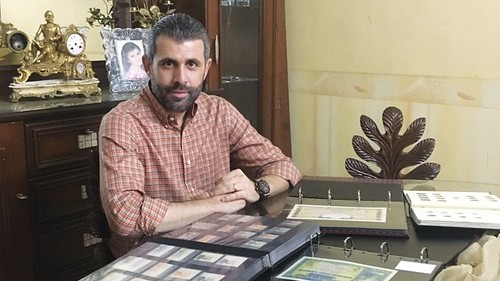
PREV ARTICLE
NEXT ARTICLE
FULL ISSUE
PREV FULL ISSUE
ARTICLE PROFILES SYRIAN BANKNOTE COLLECTOR
This article from the Newsweek Middle East edition profiles a collector of Syrian banknotes and stamps. -Editor

What started at the age of 12 as a hobby quickly turned into an obsession, and today, Jamil Murad is the number one collector of Syrian stamps and banknotes in the country. The 37-year-old, originally from Sednaya, Syria, has dedicated his life to documenting the rise and growth of the Syrian state. The collection itself is fascinating as it reflects periods of occupation, wars, and refugees in Syria, much like what is happening today. If anything, Murad’s hobby is a standing testament that history does repeat itself in itself, somehow. His living room is home to dozens of heavy albums holding thousands of stamps, banknotes, coins and historical documents, and he specializes in the period of the Syrian Republic. “For me, these collections are like a walk through Syria’s history, and it is important to protect and treasure that,” he says. The very first stamps issued in Syria, which he owns, dates back to 1919. “The collection begins when Syria began,” he says. Holding up the stamp, he points out, “These are French stamps with an over-print on them reading T.E.O., which stands for ‘Territory of Enemy Occupation.’” Holding up a series of stamps from 1925, it is possible to read “secours aux refugee” printed across them. “This was when the Armenian refugees came to Syria, fleeing the Turkish genocide,” Murad explains. “The Syrian state created a special tax in order to raise money for the Armenians.” And perhaps that could be one lesson to those who lack the funds to aid today’s Syrian refugees. Much like what is happening today, Syria was subject to attempts of dividing it. At one point, the French attempted to separate Syria into several states or ‘autonomous regions,’ which lasted for two years. In 1936 Syria signed the Independence Treaty, and again new stamps were issued. Other stamps in his collection highlight the significant dates within Syria’s history. In 1938, for example, when Turkey’s founding father Kamal Ataturk died, stamps in Syria were printed with a black border, to mark his passing. Today, it is doubted that Syria would do the same if a Turkish official died, given the turbulent and severed relations between both countries. Murad has one of the most expansive collection of Syrian banknotes in the country’s history. One of the rare notes in his collection is a 100 Lira note, the equivalent of what 1.5 million Liras would be today. But the rarest note in his collection is the 1939 250 Lebanese Lira. “The note itself was worth around $16,000 back then, as there are only four known to exist,” he says proudly.
Something tells me that reading this article is why I had a dream the other night about being in a post office in Syria. -Editor
To read the complete article, see:
Wayne Homren, Editor The Numismatic Bibliomania Society is a non-profit organization promoting numismatic literature. See our web site at coinbooks.org. To submit items for publication in The E-Sylum, write to the Editor at this address: whomren@gmail.com To subscribe go to: https://my.binhost.com/lists/listinfo/esylum All Rights Reserved. NBS Home Page Contact the NBS webmaster 
|